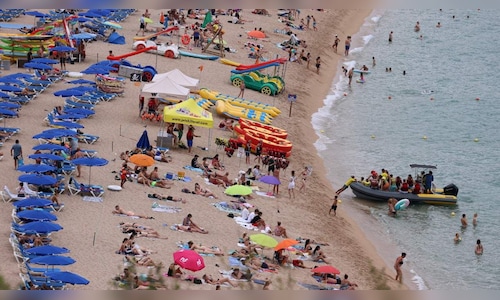According to latest official data by consultancy firm inAtlas, Spain’s 25 most popular Mediterranean and Atlantic coasts witnessed a decline of 800,000 domestic tourists last year, even as the number of foreign travellers rose by nearly two million. The world’s second-most visited country, behind only France, is now on track to host 100 million international visitors in 2024.
“Prices have risen outrageously. The whole Spanish coast is very expensive,” said 26-year-old Wendy Davila, who scrapped plans for a trip to Cádiz with her partner due to high costs, Reuters reported. Instead, they opted for the inland city of Burgos, known for its Gothic cathedral and the tomb of the legendary medieval warrior El Cid. “Now you don’t go on holiday wherever you want, but wherever you can,” she added, recalling more affordable family holidays in Alicante during her childhood.
With a population of 48 million and tourism contributing over 13% to GDP, Spain’s economy is deeply reliant on visitors. But discontent is growing, particularly over the housing crisis worsened by short-term rentals, and now by the increasing exclusion of locals from holiday spots they once enjoyed.
Also read | Cheapest destinations in Asia to travel for a lavish vacation between July-August
Over the past three years, hotel rates have surged by 23% to an average of €136 per night, according to tourism analytics firm Mabrian. Beachside rentals have also jumped by 20.3% since mid-2023, with the majority already fully booked for summer by the first quarter, data from property monitoring firm Tecnitasa shows.
“It is becoming increasingly difficult for Spanish holidaymakers to afford beachfront tourism rentals,” said Tecnitasa Group President José María Basáñez.
InAtlas found that foreign tourists stayed an average of eight nights at top coastal destinations last year, while Spaniards could only afford to stay half as long, spending just a quarter as much. The disparity is affecting not just the coast—Spanish holidaymakers made nearly 400,000 fewer trips to major cities in 2024 compared to the previous year, even as international visitor numbers to urban areas increased by close to three million.
Also read | Tourism in Spain projected to slowdown due to geopolitical uncertainties
To counter overtourism and address growing concerns, the Spanish government has launched initiatives to promote lesser-known regions away from the packed beaches and city centres. In June, Tourism Minister Jordi Hereu introduced a campaign aimed at showcasing inland Spain as an appealing alternative.
“If we want to continue to be leaders in international tourism, we have to decentralise our destinations,” he said. “We want Europeans and those from other continents to rethink their idea of the Spain they love and visit so much.”
Many locals appear to be doing just that. As rental prices soar in hotspots like Catalonia and the Balearic Islands, increasing numbers of Spaniards are turning to more affordable inland areas in Andalucía, Castile and León, and other rural regions. According to inAtlas, 1.7 million more Spaniards chose to holiday in these interior parts last year.
In the mountainous town of El Bosque, located about 100 kilometres from the popular beaches of Cádiz, domestic tourism rose by 22% in 2023. “There may be a certain displacement effect,” observed Juan Pedro Aznar, an economist and researcher at Madrid’s ESADE Business School. He noted that local residents are at a financial disadvantage compared to wealthier foreign visitors, particularly from countries like the UK and Germany.
Some have opted to skip the summer travel season altogether. Nurse María de la Jara, 51, will remain in Madrid and visit her family in Cádiz only after the peak season has ended. “I used to go to my family’s house, but there are more and more foreign tourists in Cádiz and when a cruise ship arrives, the population doubles,” she said.
As Spain’s popularity among global travellers continues to rise, concerns remain about how its own citizens can continue to enjoy the landscapes and beaches that have long been part of their national identity.
(With inputs from Reuters)





